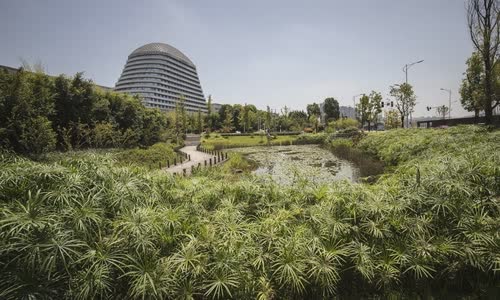The "Sponge City" builds rooftop gardens, permeable sidewalks and underground storage tanks to control flood risks from rivers.
In an old town in Chongqing City, on the banks of the Changjiang River, shop owner Liu cleaned up the mess after last month's flood.

Water discharged from the Three Gorges dam to reduce flood pressure in Nghi Xuong, Hubei province on July 19 Photo: AFP.
Pedestrians quickly passed and left Liu behind in the aftermath of a disaster that happened almost every year, costing millions of dollars and even hundreds of lives, when failing to stop floods from the rivers.
"None of us thought the floods would be that serious," said 63-year-old Liu.
For centuries, China has tried to control rivers with dykes, dams or canals to "make high mountains bow and rivers get out of the way" as the late chairman Mao Zedong said.
However, China's rapid urbanization is making the situation worse.
Therefore, the Chinese government decided to find a new solution to this situation.
Chinese cities have been partially flooded because most of the land that helps absorb rainwater, such as grasslands, forests and lakes, has been paved with stones, forcing the water to flow directly into the faulty drainage system.
The "sponge city" initiative launched in 2015 is an attempt to reverse this situation by absorbing heavy rainwater and allowing it to slowly flow into reservoirs and rivers.
"We need to give back space to water. We should see water as a precious resource, not an enemy," said Du Khong Kien, professor of landscape architecture at Peking University.
Duyet Lai is one of the Chinese government's test sites.
While Liu and many other store owners in the old town were cleaning up their muddy store, Duyet Lai, located on the banks of the Gia Linh River, there was little sign of flooding.
Chongqing sits atop a 600-kilometer reservoir created by the $ 24 billion Three Gorges Dam, China's largest flood risk reduction project.
The Three Gorges Dam was designed to withstand the worst floods in 10,000 years, protecting downstream areas like Wuhan city.
Wuhan was once dubbed the "city of hundred lakes", referring to its vast floodplain area, which was used as the annual floodwater absorbent of the Changjiang River.
"China has lost most of its natural wetlands along the Yangtze River, so there is no room for water to drain," said Jennifer Turner, director of the China Environment Forum at the Wilson Center, in Washington, USA.

The water reservoir was built in Duyet Lai sea sponge city Photo: Bloomberg
Dams "may help control flooding in normal years, not this year," says Darrin Magee, professor of environmental studies at Hobart & William Smith University in New York, who predicts day floods.
The Chinese government and dam management confirmed that flooding downstream would be worse without the Three Gorges dam, as the amount of water flowing out of the reservoir was much less than the inflow.
As floods hit southern China in July, the National Development and Reform Commission pledged to spend an additional 1.29 trillion yuan (more than $ 184 billion) on 150 flood prevention projects, such as construction.
Although Beijing's policy has saved lives for many people, floods remain the biggest headache facing China in decades.
Professor Du at Peking University says senior leadership has recognized a more "green" approach as necessary but it is difficult to change deeply edged positions at the provincial level.
The major environmental and economic strategies introduced by Beijing often have difficulty implementing them at the local level.
Near the 5-star Wyndham hotel in Duyet Lai, bulldozers and scoopers were flattening former green-covered hills.
"Builders cut trees, clear the grass, build houses and then plant decorative trees so that it looks like a sponge city. They make a lot of money from it," said Chongqing, a taxi driver in Chongqing.
Many ambitious projects in the sea sponge city have been overlooked.
In addition, many people believe that it is also difficult to "green" the old cities.
"It is very difficult to overcome the problems that persist in some areas of the city where are overpopulated or poorly planned," said Yang Boi Feng, professor of architecture and urban planning at Chongqing University.
However, the sponge city initiative remains a sign that China is slowly changing and that its outlook on development at all costs is less and less popular.
"I want people to stop changing nature, but telling China to stop growing at this time is not realistic," said Du Kiem Phong, founder of the Community Culture Center group for Environmental Protection.



 Aroha Samuels
Aroha Samuels







